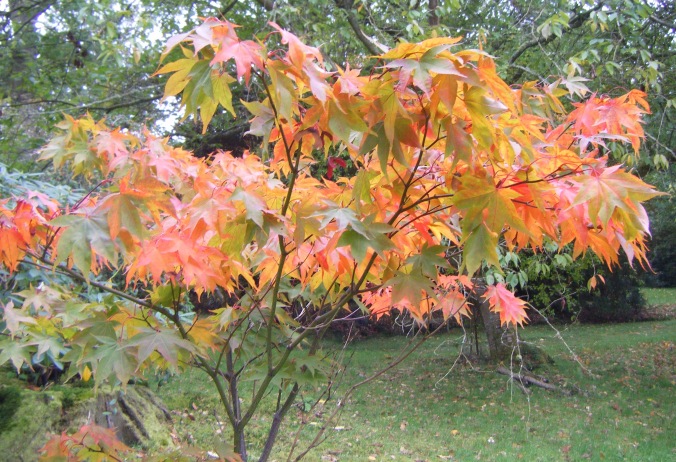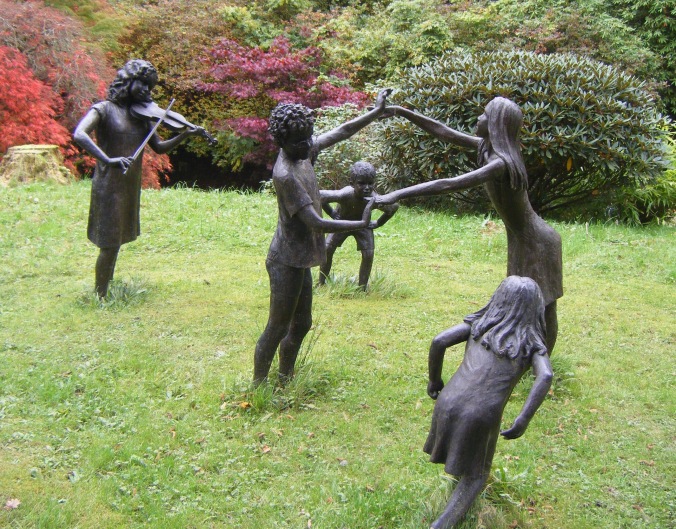For The Ninetieth garden I was invited to see a very special garden at Stoke Mandeville Hospital, Aylesbury in Buckinghamshire.
The day of the visit, last Monday the sky was a dull grey and there had been heavy snow the previous day.

The Hospital is famous for its National Spinal Injuries Centre, one of the largest specialist spinal units in the world. Just outside the entrance is this life size (5’6″/1.70m) statue by Mark ‘Jacko’ Jackson of Professor Sir Ludwig Guttman. Affectionately known as “Poppa” he was the global founder of successful spinal cord injury treatment. The government asked him in 1948 to set up the specialist spinal ward which then expanded into this amazing centre. He is also father of the Paralympic Games.

The garden has not actually been created yet, but the intention is to transform this a rather bland paved area adjoining the Spinal Care Wards into a garden; and so bringing a touch of nature and beauty to patients and their families in an accessible oasis of calm attached but away from the clinical environment. This will be Horatio’s Garden.

Photo from http://www.horatiosgarden.org.uk
Same site but a rather different scene that greeted us last Monday!

Horatio was a young man who was a volunteer in his school holidays at the Duke of Cornwall Spinal Treatment Centre, Salisbury. He and his father, a spinal surgeon at Salisbury Hospital came up with the idea for a garden and Horatio organised a questionnaire to find out what the patients wanted. Horatio was never to see the garden which was created in his memory after he was so tragically killed at the age of 17 by a polar bear in northern Norway.

http://www.horatiosgarden.org.uk/about-us/what-we-do/
Horatio’s Gardens have been completed in Salisbury and Glasgow, and now Stoke Mandeville is the latest creation. The ‘L’ shaped site is situated in the middle of this busy hospital.
 Garden designer, RHS Gold Medallist and great gardening guru Joe Swift was on hand to explain his design.
Garden designer, RHS Gold Medallist and great gardening guru Joe Swift was on hand to explain his design.

This is the projection of his perceived plan:

Picture taken from http://www.horatiosgarden.org.uk
Excavation work started back in August when Sir Robert McAlpine generously supported the removal of 1,800 tonnes of spoil. The tyre marks show the route of the trucks and lorries that exited the site through the public car park.

The site was levelled and is being prepared for the permeable bonded resin paving to be laid, providing a smooth surface and making an easy transition from ward to garden for the patients in beds and wheelchairs. It is not always easy when you first have to encounter being in a wheelchair and this outdoor area will assist in gaining confidence.

Picture borrowed from http://www.horatiosgarden.org.uk
Today a trench was being dug through the heavy clay for the drainage.

Of course no site comes without its problems. First the lengthy business of moving the huge NHS power generator; tucked around the corner it is now sporting a smart new turquoise colour which helps it blend in with the building behind.

It is difficult to imagine but this will be the water feature,

Computer graphics show an elegant raised pool at a height suitable for wheelchairs. I’m afraid you will just have to imagine the sound of the gentle flow of running water.

Picture borrowed from http://www.horatiosgarden.org.uk
Perhaps the red kite soaring above was taking advantage of a bird’s-eye view.

The view from above shows the flow of the design with curves providing intimate bays, a place for those private moments never realised whilst on a ward. Spinal injury patients often need to endure a long stay in hospital.

Picture borrowed from http://www.horatiosgarden.org.uk
This unremarkable area was where the generator once stood alongside the brick wall;

it will soon to be the garden room. Being built off-site, it is expected to be installed in the New Year. Light and airy, here patients will be able to enjoy the garden even when the weather is inclement. Kitchen facilities will enable them to make a cup of tea and perhaps share lunch with visitors. Those who wish to, will also be able to participate in the volunteer-led activities that the Horatio’s Garden charity organises.
Outside the garden room a communal space will be used for informal social gatherings of patients perhaps for lunches or even live music.

Picture borrowed from http://www.horatiosgarden.org.uk
Nearby an accessible spacious greenhouse will be built. Specially equipped for patients to help with the gardening, it will be used to propagate plants for the garden and give an opportunity for patients to get involved with working with the head gardener and volunteers or just come and chat and watch. Regular garden therapy groups will use the greenhouse and the raised beds, for therapeutic activities. Herbs, salad leaves and fruit will be grown for patients to pick and enjoy.

Picture borrowed from http://www.horatiosgarden.org.uk
Horatio loved apples and so they will be well represented amongst the variety of trees that will be planted throughout the garden.
Further round the corner is the paediatric ward where the proposed garden will be used by children with spinal cord injuries giving them and their families a beautiful natural space away from the difficulties of hospital life.

Picture borrowed from http://www.horatiosgarden.org.uk
The gentle driving force behind Horatio’s vision is Dr Olivia Chapple, Horatio’s mum. Relinquishing her role as a General Practitioner she now volunteers full time for the charity not only as Chair of the Trustees but also as a porter pushing patients in their beds out into the gardens. Joe is enthusiastic about the garden and Olivia is eternally grateful for all the support her vibrant charity receives. I left Joe in a site meeting and Olivia interviewing for the important role of Head Gardener.

Every charity needs support, and there are plans for gardens at Oswestry and London. Giving is so easy…

The National Garden Scheme has donated £130,000 to this project. It is an inspirational concept and with such a brilliant and sympathetic design it cannot help but bring a sense of well-being to the many spinal unit patients.
What a great finish to my Ninety and I do so look forward to reporting on its completion in 2018.

——-90——-




































